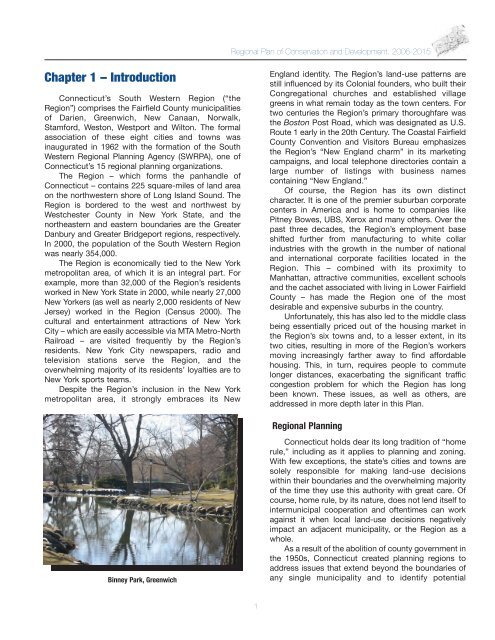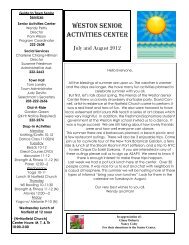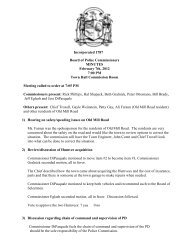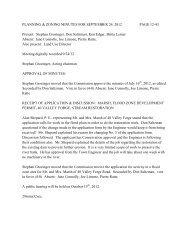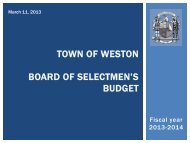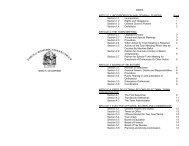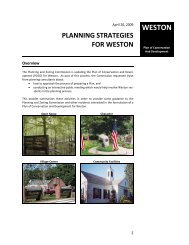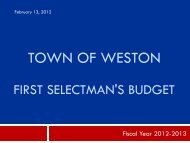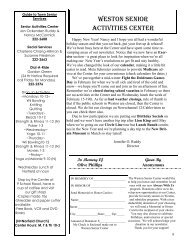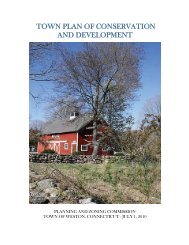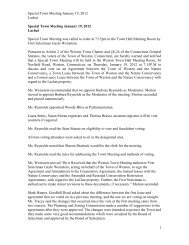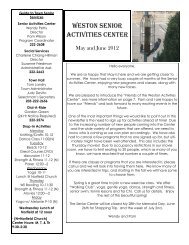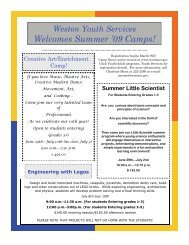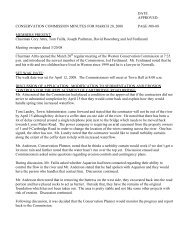Regional Plan of Conservation and Development, 2006-2015
Regional Plan of Conservation and Development, 2006-2015
Regional Plan of Conservation and Development, 2006-2015
Create successful ePaper yourself
Turn your PDF publications into a flip-book with our unique Google optimized e-Paper software.
<strong>Regional</strong> <strong>Plan</strong> <strong>of</strong> <strong>Conservation</strong> <strong>and</strong> <strong>Development</strong>, <strong>2006</strong>-<strong>2015</strong>Chapter 1 – IntroductionConnecticut’s South Western Region (“theRegion”) comprises the Fairfield County municipalities<strong>of</strong> Darien, Greenwich, New Canaan, Norwalk,Stamford, Weston, Westport <strong>and</strong> Wilton. The formalassociation <strong>of</strong> these eight cities <strong>and</strong> towns wasinaugurated in 1962 with the formation <strong>of</strong> the SouthWestern <strong>Regional</strong> <strong>Plan</strong>ning Agency (SWRPA), one <strong>of</strong>Connecticut’s 15 regional planning organizations.The Region – which forms the panh<strong>and</strong>le <strong>of</strong>Connecticut – contains 225 square-miles <strong>of</strong> l<strong>and</strong> areaon the northwestern shore <strong>of</strong> Long Isl<strong>and</strong> Sound. TheRegion is bordered to the west <strong>and</strong> northwest byWestchester County in New York State, <strong>and</strong> thenortheastern <strong>and</strong> eastern boundaries are the GreaterDanbury <strong>and</strong> Greater Bridgeport regions, respectively.In 2000, the population <strong>of</strong> the South Western Regionwas nearly 354,000.The Region is economically tied to the New Yorkmetropolitan area, <strong>of</strong> which it is an integral part. Forexample, more than 32,000 <strong>of</strong> the Region’s residentsworked in New York State in 2000, while nearly 27,000New Yorkers (as well as nearly 2,000 residents <strong>of</strong> NewJersey) worked in the Region (Census 2000). Thecultural <strong>and</strong> entertainment attractions <strong>of</strong> New YorkCity – which are easily accessible via MTA Metro-NorthRailroad – are visited frequently by the Region’sresidents. New York City newspapers, radio <strong>and</strong>television stations serve the Region, <strong>and</strong> theoverwhelming majority <strong>of</strong> its residents’ loyalties are toNew York sports teams.Despite the Region’s inclusion in the New Yorkmetropolitan area, it strongly embraces its NewEngl<strong>and</strong> identity. The Region’s l<strong>and</strong>-use patterns arestill influenced by its Colonial founders, who built theirCongregational churches <strong>and</strong> established villagegreens in what remain today as the town centers. Fortwo centuries the Region’s primary thoroughfare wasthe Boston Post Road, which was designated as U.S.Route 1 early in the 20th Century. The Coastal FairfieldCounty Convention <strong>and</strong> Visitors Bureau emphasizesthe Region’s “New Engl<strong>and</strong> charm” in its marketingcampaigns, <strong>and</strong> local telephone directories contain alarge number <strong>of</strong> listings with business namescontaining “New Engl<strong>and</strong>.”Of course, the Region has its own distinctcharacter. It is one <strong>of</strong> the premier suburban corporatecenters in America <strong>and</strong> is home to companies likePitney Bowes, UBS, Xerox <strong>and</strong> many others. Over thepast three decades, the Region’s employment baseshifted further from manufacturing to white collarindustries with the growth in the number <strong>of</strong> national<strong>and</strong> international corporate facilities located in theRegion. This – combined with its proximity toManhattan, attractive communities, excellent schools<strong>and</strong> the cachet associated with living in Lower FairfieldCounty – has made the Region one <strong>of</strong> the mostdesirable <strong>and</strong> expensive suburbs in the country.Unfortunately, this has also led to the middle classbeing essentially priced out <strong>of</strong> the housing market inthe Region’s six towns <strong>and</strong>, to a lesser extent, in itstwo cities, resulting in more <strong>of</strong> the Region’s workersmoving increasingly farther away to find affordablehousing. This, in turn, requires people to commutelonger distances, exacerbating the significant trafficcongestion problem for which the Region has longbeen known. These issues, as well as others, areaddressed in more depth later in this <strong>Plan</strong>.<strong>Regional</strong> <strong>Plan</strong>ningBinney Park, GreenwichConnecticut holds dear its long tradition <strong>of</strong> “homerule,” including as it applies to planning <strong>and</strong> zoning.With few exceptions, the state’s cities <strong>and</strong> towns aresolely responsible for making l<strong>and</strong>-use decisionswithin their boundaries <strong>and</strong> the overwhelming majority<strong>of</strong> the time they use this authority with great care. Ofcourse, home rule, by its nature, does not lend itself tointermunicipal cooperation <strong>and</strong> <strong>of</strong>tentimes can workagainst it when local l<strong>and</strong>-use decisions negativelyimpact an adjacent municipality, or the Region as awhole.As a result <strong>of</strong> the abolition <strong>of</strong> county government inthe 1950s, Connecticut created planning regions toaddress issues that extend beyond the boundaries <strong>of</strong>any single municipality <strong>and</strong> to identify potential1


